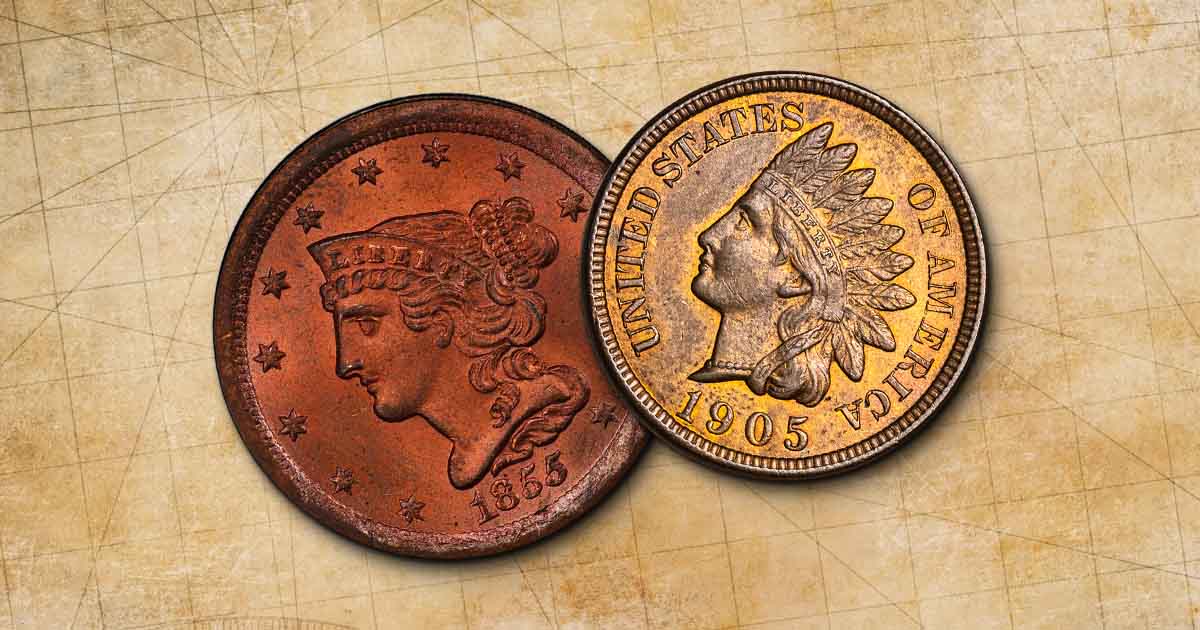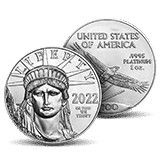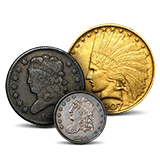
Strike characters are terms used by coin grading organizations like the Professional Coin Grading Association (PCGS) and Numismatic Guarantee Corporation (NGC) to describe the coin beyond its Sheldon score. They refer to the remaining red mint luster of copper coins, specific areas of designs on other coins, and the amount of contrast on a proof coin.
If you have been following along for the last few APMEX Answers, we recently answered questions about Red, Red/Brown, and Brown coins. These colors are used to define the class of coin they fall into by color.
How to Read Strike Characters
Strike characters help describe the strike of a coin beyond its numeric grade. You will find them listed after the numeric score and they are abbreviated.
For example, an MS-67 1916 Mercury dime is typically listed as MS-67 FB but may read MS67FB without hyphens or spaces.
Another variation of this will be MS-67 (FB) with the designation listed in parenthesis.
Do Strike Characters Change the Grade of a Coin?
Strike characters exist to better define a coin using criteria like color and strike. For instance, a penny may receive a relatively high score like MS-65, but its color could be Brown. This serves to distinguish it from a similar penny with a Red or Red/Brown character strike.
Strike Characters That Describe Color
Like in the above example, strike characters may refer to the color of a penny or other copper coin and how much of its original red mint luster remains as the copper oxidizes. These make it easier to compare coins of the same issue with similar Sheldon scores.
The colors used to describe pennies and other copper coins:
Red
Coins must exhibit 90-95% of the original reddish-orange or red color to receive a Red (RD) strike character. The Red character strike is the highest designation for copper coins by color.
Red/Brown
For a coin to receive a Red/Brown character strike, it should retain between 10% to 90% of its red mint luster. Copper coins and pennies with a Red/Brown strike character exhibit more oxidation than Red coins and in the strike character hierarchy, Red is superior to Red/Brown.
Brown
The Brown strike character is used to describe copper coins and pennies that retain less than 5-15% of their original red luster. This is the lowest strike character used to describe coins by color.
Strike Characters that Describe the Definition in a Design
We have covered these over the last few month’s Answers. Some of them require the coin in question to be in an MS-60 grade or better, and a few make exceptions for key date issues.
Full Bands
The Full Bands (FB) label is used to describe the reverse of Mercury Dimes that feature a bundle of rods or fasces with bands running horizontally that would hold the faces together. The Full Bands strike character is used to describe full horizontal bands around the faces. This requires the bands to be fully separated and indicates a strong, even strike.
Full Torch
The Full Torch (FT) strike character describes the torch on the reverse of the Roosevelt dime. To qualify for the Full Torch strike character, the upper and lower horizontal bands of the torch have to be fully separated, and there must be clearly defined vertical lines on the torch.
Full Steps
Full Steps (FS) is a strike character applied to Jefferson nickels, which features Thomas Jefferson’s home, Monticello on their reverse. Monticello had large, wide steps leading to its door. When Jefferson nickels display fully defined and unbroken step lines of 5 or more steps, the nickel is described as having Full Steps. Full Steps are indicative of clean, even strikes that bring out the full details of the design.
The Full Steps strike character is further broken down into 5FS and 6FS to distinguish between Jefferson nickels with 5 Full Steps and Jefferson nickels with 6 Full Steps.
Full Head
Full Head (FH) is a strike character you’ll see on Standing Liberty quarter slabs. This is reserved for Standing Liberty quarters that display a full head of Liberty on the obverse. Look for a full and clear separation between Liberty’s hair cords and her cap on Type I and a fully defined helmet on Type II Standing Liberty quarters.
Strike Characters That Describe Contrast
In a future Answer, we will cover strike characters that are used to grade proof coins, like Cameo, Deep Cameo, and others!
While strike characters or designations are all slightly different, they all have one thing in common: They endeavor to make the state and appearance of a coin as clear as possible. This adds value and a level of objectivity to the coin grading and valuation process.




